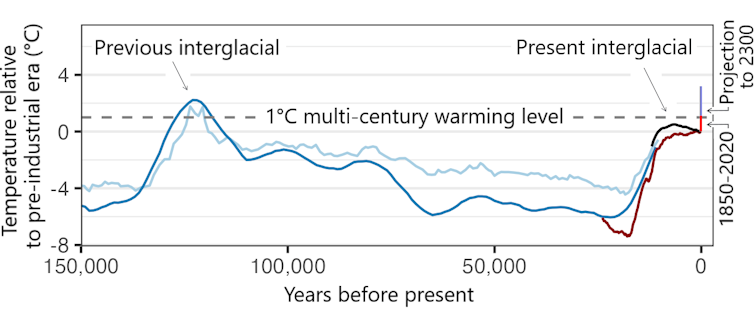





See listing of Recent and Most Popular articles on the Home Page
My World
Category: News & Current Events / Topics: Change • Coping • Crisis • Current Events, News • History • Nature • News • Research • Science & Technology • Weather
Is it Really Hotter Now than Any Time in 100,000 Years?
by Darrell Kauffman / The Conversation
Posted: July 28, 2023
Recent heat waves underscore Earth’s new climate state while revealing a fascinating history…
Editor's Note: The climate change experts warn that we are in an unprecedented, man-made crisis of global warming. The skeptics and naysayers claim it is just part of natural cycles. In a way, they are both right, and both positions must be embraced simultaneous. In the following excerpt of a July 21 article in The Conversation, Darrell Kauffman talks about a "new climate state," which it is--and in some ways isn't. He uses a chart showing the most recent interglacial periods, about 100,000 years. The other day, my wife and I watched a 2020 PBS Nova program, "Polar Extremes" in which host Kirk Johnson, (a paleontologist and Director of the National Museum of Natural History) tells the amazing story of this cycle of polar extremes—from tropical to miles-thick ice—that has repeated over and over again in roughly 100,000 year cycles. It is a complex dance of carbon absorption and release. driven in part by the wobbling tilt of earth and the influence of nearby planets on its orbit.
From what I understand, what makes our current situation a "new state," as Kauffman calls it, is that as earth began to warm at the end of the most recent interglacial period, the Industrial Revolution began, amplifying the natural cycle with its man-made contribution, driven largely by the burning fossil fuels. So, it's not so much either/or nature versus man, but a both/and, with incredibly bad timing. As Johnson pointed out, we are now exceeding atmospheric carbon dioxide levels—and global temperatures—that were last seen about 3 million years ago.
My apologies for the extended note, It was not meant to steal Darrell Kauffman;s thunder, but to add some additional perspective for you to think about. To be fair, Kauffman does touch on the longer-term nature of the interglacial cycles in the last half of the article. Following the excerpt of the article you will find a link to the full article on The Conversation, with additional resources.
As scorching heat grips large swaths of the Earth, a lot of people are trying to put the extreme temperatures into context and asking: When was it ever this hot before?
Globally, 2023 has seen some of the hottest days in modern measurements, but what about farther back, before weather stations and satellites?
Some news outlets have reported that daily temperatures hit a 100,000-year high.
As a paleoclimate scientist who studies temperatures of the past, I see where this claim comes from, but I cringe at the inexact headlines. While this claim may well be correct, there are no detailed temperature records extending back 100,000 years, so we don’t know for sure.
Here’s what we can confidently say about when Earth was last this hot.
This is a new climate state
Scientists concluded a few years ago that Earth had entered a new climate state not seen in more than 100,000 years. As fellow climate scientist Nick McKay and I recently discussed in a scientific journal article, that conclusion was part of a climate assessment report published by the Intergovernmental Panel on Climate Change (IPCC) in 2021.
Earth was already more than 1 degree Celsius (1.8 Fahrenheit) warmer than preindustrial times, and the levels of greenhouse gases in the atmosphere were high enough to assure temperatures would stay elevated for a long time.
 Earth’s average temperature has exceeded 1 degree Celsius (1.8 F) above the preindustrial baseline. This new climate state will very likely persist for centuries as the warmest period in more than 100,000 years. The chart shows different reconstructions of temperature over time, with measured temperatures since 1850 and a projection to 2300 based on an intermediate emissions scenario. D.S. Kaufman and N.P. McKay, 2022, and published datasets, Author provided
Earth’s average temperature has exceeded 1 degree Celsius (1.8 F) above the preindustrial baseline. This new climate state will very likely persist for centuries as the warmest period in more than 100,000 years. The chart shows different reconstructions of temperature over time, with measured temperatures since 1850 and a projection to 2300 based on an intermediate emissions scenario. D.S. Kaufman and N.P. McKay, 2022, and published datasets, Author provided
Even under the most optimistic scenarios of the future – in which humans stop burning fossil fuels and reduce other greenhouse gas emissions – average global temperature will very likely remain at least 1 C above preindustrial temperatures, and possibly much higher, for multiple centuries.
This new climate state, characterized by a multi-century global warming level of 1 C and higher, can be reliably compared with temperature reconstructions from the very distant past.
How we estimate past temperature
To reconstruct temperatures from times before thermometers, paleoclimate scientists rely on information stored in a variety of natural archives.
The most widespread archive going back many thousands of years is at the bottom of lakes and oceans, where an assortment of biological, chemical and physical evidence offers clues to the past. These materials build up continuously over time and can be analyzed by extracting a sediment core from the lake bed or ocean floor.
These sediment-based records are rich sources of information that have enabled paleoclimate scientists to reconstruct past global temperatures, but they have important limitations.
For one, bottom currents and burrowing organisms can mix the sediment, blurring any short-term temperature spikes. For another, the timeline for each record is not known precisely, so when multiple records are averaged together to estimate past global temperature, fine-scale fluctuations can be canceled out.
Because of this, paleoclimate scientists are reluctant to compare the long-term record of past temperature with short-term extremes.
Looking back tens of thousands of years
Earth’s average global temperature has fluctuated between glacial and interglacial conditions in cycles lasting around 100,000 years, driven largely by slow and predictable changes in Earth’s orbit with attendant changes in greenhouse gas concentrations in the atmosphere. We are currently in an interglacial period that began around 12,000 years ago as ice sheets retreated and greenhouse gases rose.
Looking at that 12,000-year interglacial period, global temperature averaged over multiple centuries might have peaked roughly around 6,000 years ago, but probably did not exceed the 1 C global warming level at that point, according to the IPCC report. Another study found that global average temperatures continued to increase across the interglacial period. This is a topic of active research.
That means we have to look farther back to find a time that might have been as warm as today.
The last glacial episode lasted nearly 100,000 years. There is no evidence that long-term global temperatures reached the preindustrial baseline anytime during that period.
If we look even farther back, to the previous interglacial period, which peaked around 125,000 years ago, we do find evidence of warmer temperatures. The evidence suggests the long-term average temperature was probably no more than 1.5 C (2.7 F) above preindustrial levels – not much more than the current global warming level.
Now what?
Read teh full article to find out, including a referene that echoes what we learned from Kirk Johnson in the Polar Extremes program about the last time is was this warm. .
Search all articles by Darrell Kauffman
Posted: July 28, 2023 Accessed 268 times
![]() Go to the list of most recent My World Articles
Go to the list of most recent My World Articles
![]() Search My World (You can expand the search to the entire site)
Search My World (You can expand the search to the entire site)
![]() Go to the list of Most Recent and Most Popular Articles across the site (Home Page)
Go to the list of Most Recent and Most Popular Articles across the site (Home Page)
 Loading requested view...
Loading requested view...